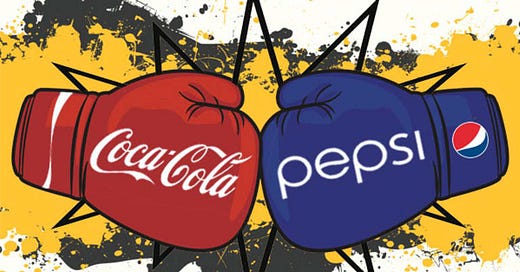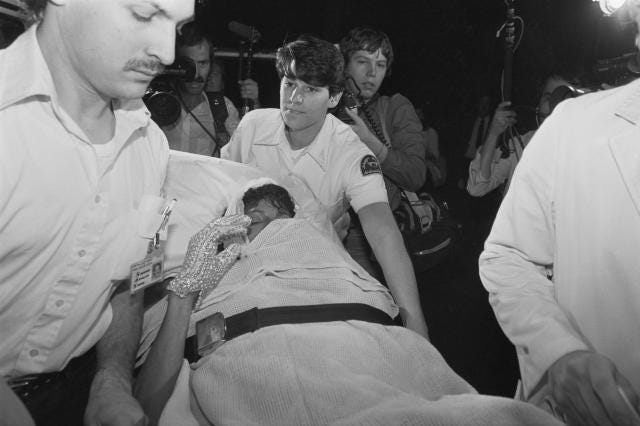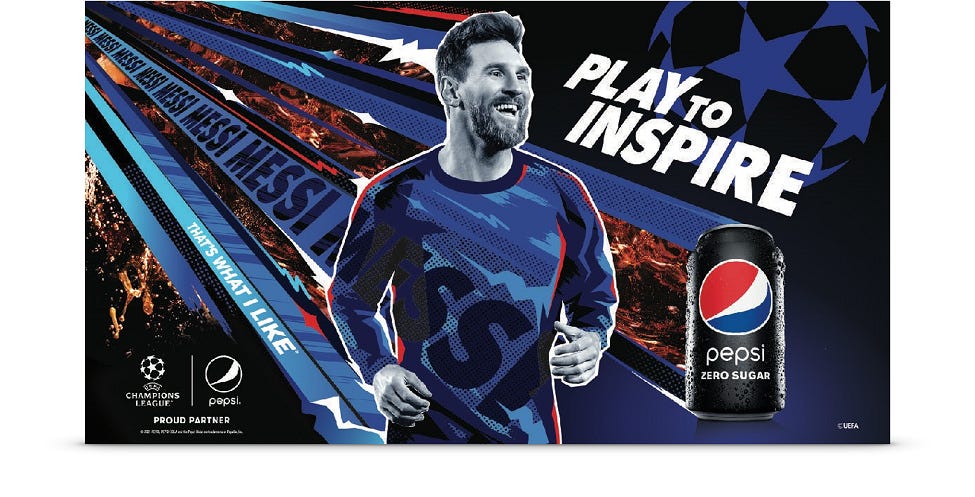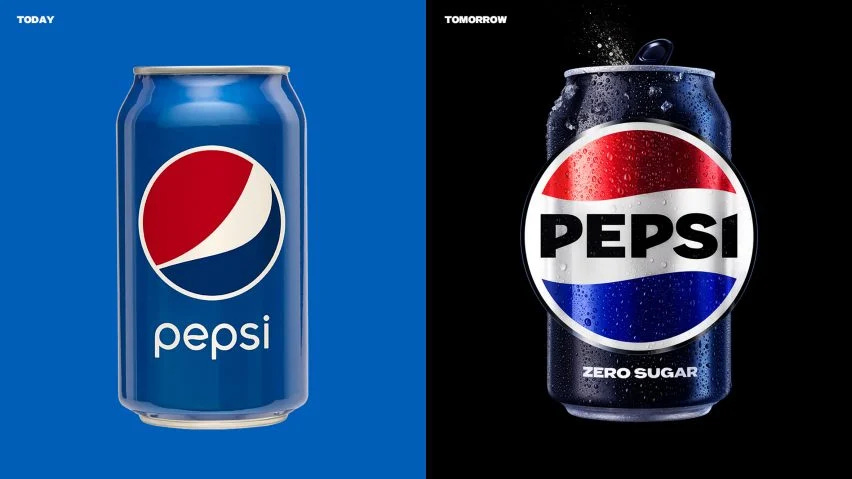The Cola Wars: Part 2
As we finish the 80s and move into the modern era, the Cola Wars are just starting to heat up...
Last week, I began the extraordinary story of the bitter cola wars that have waged between the two US soda giants for over a century.
It’s one of the longest-running and bizarre global corporate rivalries and is still raging today as the nearly identical soft drinks splash out billions to try and sneak the tiniest increase in sales.
In the red corner, we have market leader Coca-Cola, the classic American beverage, while in the blue corner slouches Pepsi, targeting the youth, but destined to always play second fiddle.
Here, I take up the story in the 1980s, after the disastrous ‘New Coke’ launch and amid the critical success of The Pepsi Challenge.
Here’s what happened next…
The Pepsi Generation
Throughout the rest of the 80s and into the 90s, Pepsi began using a new marketing tactic that would go on to become their bread and butter, influencer marketing. Securing endorsements from major celebrities like Michael Jackson and Michael J. Fox not only increased Pepsi’s visibility but also helped it to capture a significant share of the youth market.
A highlight of this strategy was the “New Generation” campaign of 1984 which involved a series of commercials featuring pop icon Michael Jackson dancing to the tune of his hit song “Billie Jean”. The lyrics were changed to revolve around Pepsi which was a radical move at the time considering just how massive the song was.
[Pre-Chorus]
You're a whole new generation, you're dancin' through the day
You're grabbin' for the magic on the run
You're a whole new generation, you're lovin' what you do
Put a Pepsi in the motion
The choice is up to you, hey-ey
[Chorus]
You're the Pepsi generation
Guzzle down and taste the thrill of the day
And feel the Pepsi way
Taste the thrill of the day
And feel the Pepsi way
[Outro]
You're a whole new generation
You're a whole new generation
You're a whole new generation
This partnership, while incredibly successful, was not without its issues, the most notable of which occurred on January 27th, 1984 while Jackson was filming for a Pepsi commercial. During the sixth take, a firework went off early causing the pomenade in Jackson’s hair to catch on fire. This resulted in the pop superstar receiving 2nd and 3rd degree burns on his scalp which led to a $1.5 million settlement.
Not the best look for Pepsi but it did lead to a lot of free publicity so I guess there’s that. It’s also clear Jackson didn’t hold a grudge as he would go on to sign another partnership deal with Pepsi to the tune of $10 million for his 1987-88 ‘Bad’ tour.
From Pop Stars To Polar Bears
Throughout the 1990s, Pepsi doubled down on its connection with youth culture, further cementing its image as the choice of a new generation. This era saw Pepsi leveraging the star power of superstars beyond Michael Jackson, including other pop sensations like Britney Spears and boy band phenomenon NSYNC. Their ads often featured catchy tunes, vibrant visuals, and a vibe of youthful rebellion.
A prime example was the 1992 Super Bowl commercial featuring Cindy Crawford, which became iconic not just for its celebrity appeal but for how it positioned Pepsi as a “cool” drink. Pepsi’s approach was clear: align the brand with icons of popular culture to maintain relevance and appeal among the younger, trend-setting audiences.
Coca-Cola, on the other hand, took a slightly different route that aimed at invoking nostalgia while also embracing universal themes of unity and joy. Coke's "Always Coca-Cola" campaign, which launched in 1993, was a series of whimsical and heartwarming ads that featured polar bears and animated vignettes, painting Coke as a timeless classic that brings people together.
The Rise Of Digital Marketing
Entering the new millennium, both companies ventured into digital marketing, but with differing emphases. Pepsi embraced the digital age with initiatives like the Pepsi Refresh Project in 2010, an online cause-marketing campaign that funded ideas submitted by consumers aimed at improving communities.
This campaign was innovative in its use of social media to engage consumers directly and allowed them to vote on which projects should receive funding. It was a brilliant move that aligned Pepsi with social responsibility and grassroots involvement, resonating well with a generation that valued activism and direct impact.
Coca-Cola’s digital strategy, meanwhile, focused on personalisation and direct consumer interaction. The "Share a Coke" campaign, which began in Australia in 2011 and spread globally, swapped the iconic Coca-Cola logo on bottles with people's names. This campaign tapped into the power of personalisation in a digital era where custom content was king.
It not only increased sales but also sparked a social media frenzy as consumers shared images of bottles with their names or those of friends and family, driving home the message that Coke was for everyone and every occasion.
The only major issue with this campaign was the simple fact consumers were given the freedom to customise the product. As you can imagine, some people saw this as an opportunity to share a very different kind of message.
Regardless, this campaign was a huge hit. To give you an idea of just how successful this promotion was, within a month of its launch in Australia, sales had increased by 7% and, when the campaign ended, it had generated 1.5 billion custom bottles of Coke and 100 million social media interactions.
The Cola Wars Today
At last we find ourselves in the 2020s with the rivalry as strong as ever. For Coca-Cola, the current marketing approach revolves around the "Real Magic" platform, which includes a refreshed visual identity and a global campaign that seeks to emphasise the magic of human connections.
One example of this is the "One Coke Away From Each Other" ad. It used modern technology in a bid to target the gaming community by featuring hidden codes people could redeem to play games with their favourite gaming influencers. This innovative ad received positive feedback from the general public but it faced sharp backlash from the gaming community as it showed gamers actually getting along.
As an avid gamer myself, I can tell you this very far from the truth. Just join any Call of Duty lobby and you’ll hear what I mean. Regardless, this ad reflects a shift away from traditional broadcasting methods to more experiential and interactive formats, with the goal of connecting with consumers on a more personal and engaging level.
Meanwhile, Pepsi has been leveraging its historical strength by aligning with cultural icons and events. For instance, it has recently engaged in a high-profile partnership with the UEFA Champions League which allowed Pepsi to utilise the star power of famous footballers in their advertising to maintain its image as a vibrant and youthful brand.
However, not all of Pepsi’s attempts to appeal to the youth have been successful. Cast your mind back to 2020, Trump was president facing a re-election and the Black Lives Matter movement was in full swing following the death of George Floyd at the hands of police. What a time that was. The emotions, the anger, the pain; it was a time of self reflection and many questions.
And Pepsi saw this moment and thought “How could this make us money?”. A short while later they had spent millions on a ad featuring Kendal Jenner joining a peace protest before bravely walking up to a line of police and offering a Pepsi. The crowd erupts with cheers and the issue is seemingly solved.
Now, there’s nothing wrong with advocating for a good cause but it has to be backed up with a genuine effort at helping. This ad failed at this on all fronts as Pepsi didn’t donate to anything and they appeared to be suggesting the ongoing protests against institutional racism in the police force could be solved with a sugary can of goodness. Queue a branding disaster followed by the classic deletion and apology.
In a move completely unrelated to this PR disaster, in 2023 Pepsi decided it was time for a rebrand. It updated its logo in a move it claimed reflected its shift into the digital era. The new design uses elements of older Pepsi logos which taps into the powerful emotional marketing tool of nostalgia while also adopting a modern colour palette to strengthen its position as a drink of the younger generation. Given that the previous rebrand in 2008 cost $1.2 billion and was widely criticised, I’d say this has been a success.
Looking Into The Future
As we look to the future, the rivalry between Coca-Cola and Pepsi is set to intensify, adapting to new marketing landscapes and evolving consumer trends. Both companies have historically navigated cultural shifts and technological advancements to maintain their market presence, a trend that will likely continue as digital platforms evolve. This may lead to increased investments in digital marketing and social media engagement, featuring more personalised advertising, interactive campaigns, and innovative virtual reality experiences to enhance brand interaction.
Simultaneously, with sustainability and ethical business practices gaining importance, especially among younger consumers, both brands are expected to deepen their commitment to environmental initiatives and corporate social responsibility. This could see them competing not only on taste and lifestyle alignment but also on their environmental impact and support for global and local social causes, including setting aggressive carbon footprint reduction targets, improving recycling efforts, and backing significant social issues.
Regardless of the future, it’s clear that the rivalry between Pepsi and Coke is more than just a battle of two soft drinks; it's a story of strategic evolution, cultural influence, and immense brand power. From humble beginnings each company has taken a simple product and used clever marketing to dominate the global market. From iconic jingles and taste tests to star power and rebrands, this story has been a rollercoaster ride of marketing wins and fails that have shaped the world of advertising as we know it.
However, despite how influential this rivalry has been, I think it is also important to recognise that, at the end of the day, both these companies are trying to sell you sugary carbonated water. When scientific studies have shown both products are chemically identical, does it really matter which you prefer?









Thanks for this post - really enjoyed going over this again - it's a great case study and as you say, it will continue to be so. Two sugary drinks that may not be too popular as people wake up to the health issues of both of these but I guess both will suffer at a similar rate ?